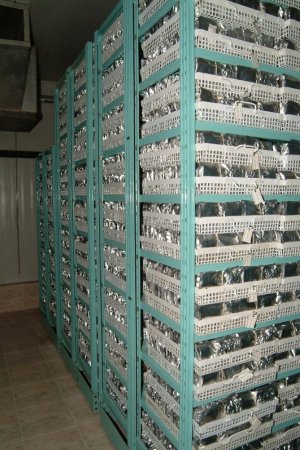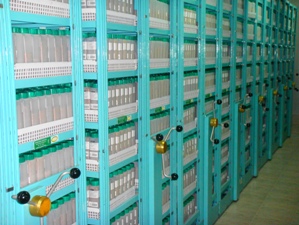Storage of cultivated barley and wild relatives genetic resources
Contributors to this page: ICARDA, Syria (Ahmed Amri, Bilal Humeid, Kenneth Street, Natalya Rukhkyan, Jan Konopka, Siham Asaad, Adnan Omran and Fida Alô).
|
Contents: |
Base collection
|
The base collection at ICARDA (photo: ICARDA) |
A base collection is a long-term storage. The initial population is used as a bench mark for monitoring changes in genetic diversity over time and after several cycles of regeneration due to genetic drift. It should insure that an accession’s seed viability remains at acceptable levels for at least 50 years, or for at least one regeneration cycle of the accession.
When it should be used
- It should be used to hold seed samples for long-term conservation.
- It should serve as a duplicate and safety collection of the active collection's long-term conservation.
- It must reduce the number of regeneration cycles for the conservation of the genetic integrity of the accessions.
- It should provide the foundation seeds for regeneration of the genebank accessions.
- It should also provide seed samples of the accessions for seed requests and seed exchange, as it conserves all the accessions of the genebank.
- It acts as a black-box seed storage for the safety deposit of the accessions of the cooperative genebanks.
- Its function and operation should be supported in the long term by core or essential funding of the institution or government.
Sample specifications
These are required to choose a representative sample and to avoid genetic drift.
Minimum sample size for storage
- Cultivated barley: two packets of 25 g each.
- Barley wild relatives: one packet of 25 g.
Minimum viability for storage
- Cultivated barley: >90%.
- Barley wild relatives: >80%.
Moisture content
- 5-7% (to avoid any deterioration of the stored seed samples).
Container specifications
Seed packaging method
- Aluminum foil packets sealed under vacuum (these are moisture-proof and occupy less space than other containers).
- Packing is best carried out in an air-conditioned room with controlled humidity, as quickly as possible after drying (to prevent the re-absorption of water).
Specifications of packaging material
-
Aluminum foil packets consisting of the following layers:
- Polyester 17 g/m².
- Alufoil 33 g/m².
- Polyethylene 63 g/m².
Storage specifications
Assigning location codes
- It is preferable to use sliding shelves (for easy access to the accessions).
- Record the position of each accession in the store, e.g. unit/block number, row shelf number, shelf number and tray number.
Storage conditions
- -18 to -22°C (maintains seed viability) in cold walk-in rooms or in freezers (preferably vertical freezers).
Recording information during storage - Base collection
The following information should be recorded for each step:
- Accession number (unique number).
- Weight of the sample (g).
- Estimated number of seeds (estimated from 1000 kernel weight).
- Year of regeneration (date).
- Viability (%).
- Viability test date (date).
- Recommended next viability test date (date).
- Phytosanitary status (approved, conditionally approved, rejected).
- Position of the sample in the storage facility (coordinates).
|
The active collection at ICARDA (photo: ICARDA) |
An active collection consists of accessions that are available for distribution and are accessed frequently. The active collection is intended to preserve germplasm viability in medium-term storage conditions for at least 20 years or for half of one regeneration cycle in the base collection.
When it should be used
- The active collection should be used to hold seed samples for medium-term conservation.
-
The active collection is important to:
- Conserve accessions most actively used or expected to be used such as elite lines and populations, core subsets and reference seed sets of all accessions.
- Distribute seed samples requested by users.
- Store introductions and the regenerated seeds before inventorying them.
Sample specifications
Minimum sample size for storage
- Cultivated barley: 1500 seeds (L flag) (this is a representative sample).
- Wild species: 1500 seeds (L flag).
Viability for storage
- Cultivated barley: > 90%.
- Wild species: > 80%.
Moisture content
- 5-7% (to avoid any deterioration of the stored seed samples).
Container specifications
Seed packaging method
Use permeable plastic containers (this will create the balance between seed moisture content and the ambient relative humidity).
Specifications of packaging material
- Square-based bottles with a screw cap made of pure plastic material (high quality), semi transparent, white in colour, volume (400 ml) (as used at ICARDA). These are moisture resistant and withstand storage at low temperature for a long period of time without cracking or any other physical deterioration.
Storage specifications
Assigning location codes
- It is preferable to use sliding shelves (for easy access to the accessions).
- Record the position of each accession in the store, e.g. unit/block number, row shelf number, shelf number and tray number.
Storage conditions:
- 3 ± 2oC (extends the storage life and breaks any dormancy if present). Relative humidity controlled at 15-20% if seeds are stored in permeable plastic containers.
Recording information during storage - Active collection
The following information should be recorded for each step:
- Accession number.
- Weight of the sample.
- 1000 kernel weight.
- Number of seeds (estimated from weight using 1000 kernels).
- Number of packets.
- Year of production of seeds.
- Viability (%).
- Viability test date.
- Recommended next viability test date.
- Flag for regeneration (Y/N).
- Position of the sample in the storage.
- Flag indicating distribution status (A-available for distribution; L-limited stock; S-stop distribution).
For information on safety duplication in seed banks, click here.
Storage management
Provides guidance on how to arrange the physical space, how to track seed material and record information during storage.
Storage space arrangement
It is very important to provide easy access to the accessions.
Room
- Use the minimum space possible (to reduce the cost of cooling the storeroom), but allow convenient access to each sample.
Shelves
- Sliding shelves should preferably be used (to maximize space between and on the racks in the store and to provide easy access to the accessions).
- Shelves should be spaced slightly higher than the height of the containers.
- Record the position of each accession in the store, e.g. unit/block number, row shelf number, shelf number and tray number.
System for tracking material/inventory system
- It is important to use a database to keep track of stock and location of material, and to use barcodes (databases are needed to keep track of information; barcoding helps to avoid errors in recording).
Recording information during storage
The following information must be recorded for each consignment:
- Accession number (ID number).
- Lot number (ID number).
- Weight of seeds (weight of seeds in store).
- Number of seeds (number of seeds in store).
- Thousand seed weight (weight of 1000 seeds).
- Number of packets (number of containers for seeds of one lot of each accession).
- Location of containers (store, shelf or box number).
- Type of container (material and size of container).
- Year of production of seeds (indicates age of seeds).
- Flag for regeneration (Y/N).
- Flag indicating distribution status (A-available for distribution; L-limited stock; S-stop distribution).
- Year of safety duplication (year).
- Institute holding the duplicate (name of institute holding the safety duplication).
- Location of duplicate sample (box label where the duplicate sample is placed).
References and further reading
Rao NK, Hanson J, Dulloo ME, Ghosh K, Nowel D, Larinde M. 2006. Manual of seed handling in genebanks. Handbooks for Genebanks No. 8. Bioversity International, Rome, Italy. Available in English (1.5 MB), Spanish (1.4 MB) and French (1.9 MB).
Comments
- No comments found







Leave your comments
Post comment as a guest